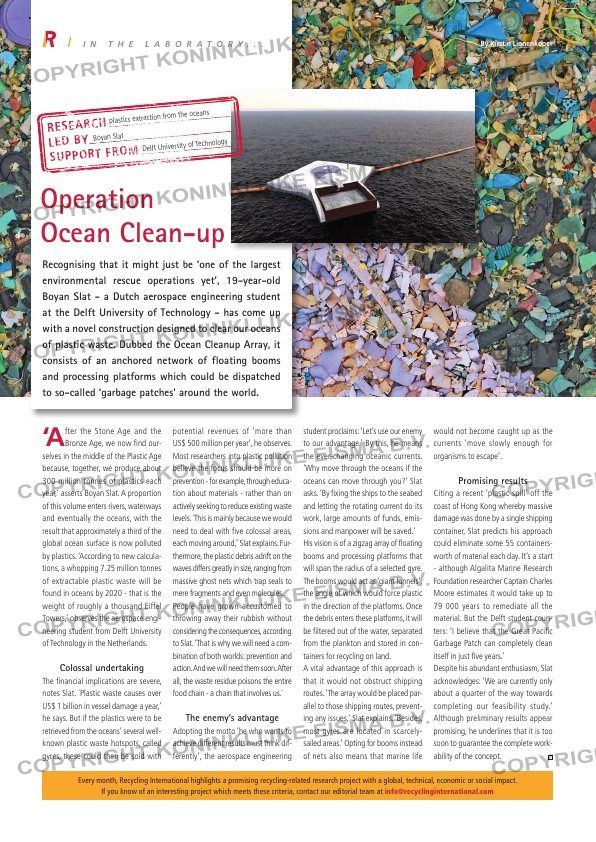Page 111 from: May 2013

I N T H E L A B O R A T O R Y . . .
would not become caught up as the
currents ‘move slowly enough for
organisms to escape’.
Promising results
Citing a recent ‘plastic spill’ off the
coast of Hong Kong whereby massive
damage was done by a single shipping
container, Slat predicts his approach
could eliminate some 55 containers-
worth of material each day. It’s a start
– although Algalita Marine Research
Foundation researcher Captain Charles
Moore estimates it would take up to
79 000 years to remediate all the
material. But the Delft student coun-
ters: ‘I believe that the Great Pacifi c
Garbage Patch can completely clean
itself in just fi ve years.’
Despite his abundant enthusiasm, Slat
acknowledges: ‘We are currently only
about a quarter of the way towards
completing our feasibility study.’
Although preliminary results appear
promising, he underlines that it is too
soon to guarantee the complete work-
ability of the concept.
‘After the Stone Age and the Bronze Age, we now fi nd our-
selves in the middle of the Plastic Age
because, together, we produce about
300 million tonnes of plastics each
year,’ asserts Boyan Slat. A proportion
of this volume enters rivers, waterways
and eventually the oceans, with the
result that approximately a third of the
global ocean surface is now polluted
by plastics. ‘According to new calcula-
tions, a whopping 7.25 million tonnes
of extractable plastic waste will be
found in oceans by 2020 – that is the
weight of roughly a thousand Eiffel
Towers,’ observes the aerospace engi-
neering student from Delft University
of Technology in the Netherlands.
Colossal undertaking
The fi nancial implications are severe,
notes Slat. ´Plastic waste causes over
US$ 1 billion in vessel damage a year,’
he says. But if the plastics were to be
retrieved from the oceans’ several well-
known plastic waste hotspots, called
gyres, these could then be sold with
student proclaims: ‘Let’s use our enemy
to our advantage.’ By this, he means
the ever-changing oceanic currents.
‘Why move through the oceans if the
oceans can move through you?’ Slat
asks. ‘By fi xing the ships to the seabed
and letting the rotating current do its
work, large amounts of funds, emis-
sions and manpower will be saved.’
His vision is of a zigzag array of fl oating
booms and processing platforms that
will span the radius of a selected gyre.
The booms would act as ‘giant funnels’,
the angle of which would force plastic
in the direction of the platforms. Once
the debris enters these platforms, it will
be fi ltered out of the water, separated
from the plankton and stored in con-
tainers for recycling on land.
A vital advantage of this approach is
that it would not obstruct shipping
routes. ‘The array would be placed par-
allel to those shipping routes, prevent-
ing any issues,’ Slat explains. ‘Besides,
most gyres are located in scarcely-
sailed areas.’ Opting for booms instead
of nets also means that marine life
potential revenues of ‘more than
US$ 500 million per year’, he observes.
Most researchers into plastic pollution
believe the focus should be more on
prevention – for example, through educa-
tion about materials – rather than on
actively seeking to reduce existing waste
levels. ́ This is mainly because we would
need to deal with fi ve colossal areas,
each moving around,’ Slat explains. Fur-
thermore, the plastic debris adrift on the
waves differs greatly in size, ranging from
massive ghost nets which trap seals to
mere fragments and even molecules.
People have grown accustomed to
throwing away their rubbish without
considering the consequences, according
to Slat. ‘That is why we will need a com-
bination of both worlds: prevention and
action. And we will need them soon. After
all, the waste residue poisons the entire
food chain – a chain that involves us.´
The enemy’s advantage
Adopting the motto ‘he who wants to
achieve different results must think dif-
ferently’, the aerospace engineering
Operation
Ocean Clean-up
Recognising that it might just be ‘one of the largest
environmental rescue operations yet’, 19-year-old
Boyan Slat – a Dutch aerospace engineering student
at the Delft University of Technology – has come up
with a novel construction designed to clear our oceans
of plastic waste. Dubbed the Ocean Cleanup Array, it
consists of an anchored network of floating booms
and processing platforms which could be dispatched
to so-called ‘garbage patches’ around the world.
By Kirstin Linnenkoper
Every month, Recycling International highlights a promising recycling-related research project with a global, technical, economic or social impact.
If you know of an interesting project which meets these criteria, contact our editorial team at [email protected]
RESEARCH
LED BY
SUPPORT FRO
M
plastics extractio
n from the ocean
s
Boyan Slat
Delft University o
f Technology
RI-4_In the laboratory.indd 111 03-05-13 13:47



